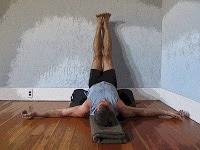 |
| Legs Up the Wall Pose (Viparita Karani) |
Q: I’ve heard that some people should not do inversions, but you didn’t mention this in your post on Wednesday about inverted poses. Could address this?
A: Oops! My bad, as Buffy would say. It’s true that for certain medical conditions, inverted poses are, as they say, contraindicated. So I’m sorry I did not mention this earlier in my post Just in Time for the Holidays: Inverted Poses.
First off, the poses you may need to be concerned about only include the full inversions and some of the partial inversions that are held for long periods of time.
If you have high blood pressure that is uncontrolled with medication, you should not do inverted poses, because, as I explained in my post (see here) they temporarily raise your blood pressure. And even if your high blood pressure is controlled with medication, talking with your doctor before doing full inverted poses is probably a good idea. People with heart problems should also consult their doctors.
If you are having eye problems, such as glaucoma or detached retina, inversions should also be avoided. Likewise, if you’ve recently had oral surgery. And those with neck problems should avoid the inversions that put pressure on their necks.
People with back problems will probably find that at least some of these poses may cause back pain, in which case, you should please come out of the pose and find an alternative (I’ve noticed Supported Bridge pose and Legs up the Wall pose can cause difficulties for people with lower back problems).
There are many yoga teachers who do not recommend inverted poses for women who are menstruating. However, as far as I know, there are no scientific studies to back up their concerns. What I recommend is that each of you do your own research on the subject, talking to your teachers, your gynecologist (I did that), and other female practitioners, and make up your own mind based on their advice.
Finally, if you are pregnant and not already experienced doing inverted poses, this is probably not the best time for you to start.
—Nina
Follow Yoga for Healthy Aging on Facebook ° To order Yoga for Healthy Aging: A Guide to Lifelong Well-Being, go to Amazon, Shambhala, Indie Bound or your local bookstore.


is there any problem to do full inverse poses (shoulder or head stand) to the person with PD?
HI Nina, Thank you for all your writing at YFHA. In the Iyengar tradition, inversions are avoided when women are in the menstruating cycle. There is a great article by Geeta Iyengar on this topic.
https://iynaus.org/sites/iynaus_files/pages/research/practice-of-women.pdf
In Geeta Iyengar's words, "You avoid Śīr āsana and Sarvāngāsana or any inversions during menstruation because the inversions are a hurdle to the menstruation‘s flow. The inversions arrest the flow. When you are standing on your head or on your shoulders you retain that which is only fit to be thrown out. According to Āyurveda health is maintained by throwing out whatever has to be thrown out by the body. To retain it inside means to invite disease. The toxins are to be thrown out. If the toxins, the waste matters such as sweat, urine, faeces, gas, men- strual blood and pus are retained, then the body suffers. When you are not keeping well your doctor asks, “Are you constipated? Do you pass urine properly? How much urine do you pass?” Sometimes he asks you to measure the urine you pass. Likewise during menstruation, the blood that you have to throw out definitely has to be thrown out and not retained. So during the menstrual period you avoid Śīr āsana and Sarvāngāsana in order to see that you do not retain those things which must be thrown out.